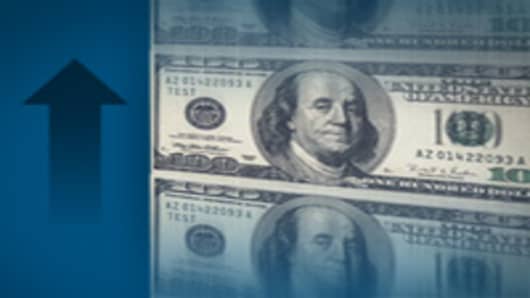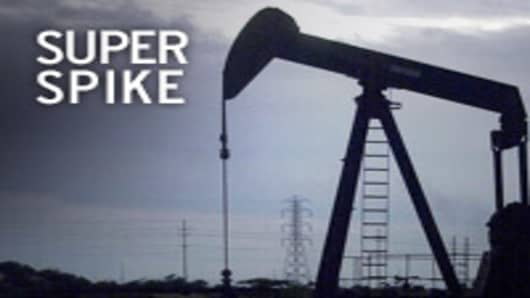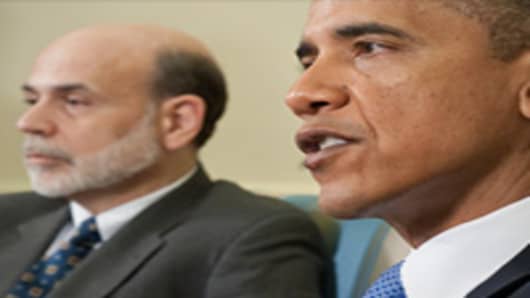Even inflation may be in the eye of the beholder.
With the unemployment rate at 9 percent and the economy posting less-than-spectacular growth in recovering from the worst downturn in seventy years, inflation may seem an unlikely threat. But that hasn't stopped a growing number of doomsayers on Wall Street and Capital Hill from crying "Fire!".
What's driving the thinking, however, is arguably less a matter of current and leading economic indicators than a powerful cocktail of empirical wisdom, deficit politics and ideological debate about the role and powers of the Federal Reserve in managing the economy.
"It's just hard to believe that you can pump all this liquidity into the system without it {inflation} popping up," says Mark Calabria of the Cato Institute and a former senior staffer on the Senate Banking Committee. "QE2 was the straw that broke the camel's back. Bernanke's the remaining face of the bailout. And if you are a run-of-the-mill Republican, then everything you don't like in government, Bernanke is for.
"The simplest answer is that during normal times, we would see inflation," says Josh Bivens of the Economic Policy Institute. "What people are missing is these are not normal times."
The big fear is enormous fiscal spending and monetary stimulus during the financial crisis and ensuing recession-recovery period will inevitably explode into a prolonged bout of unusually high inflation unless interest rates are hiked and the budget deficit shrink-wrapped.
Boom Bust Era
Such was the case n the 1960s-1070s, when massive federal spending on social programs (The Great Society) and the Vietnam War, as well as two oil shocks, created a 15-year, boom-bust cycle.
Between 1969 and 1982, the consumer price index managed to register a reading below 4 and a half percent only once, while posting double-digit gains in four other years. The Fed hiked interest rates relentlessly towards the end of the cycle to snuff out inflation
Growth was erratic in the period, which included two deep and long recessions. The economy actually shrank in four separate years, but in four others in grew by more than 5 percent.
Numbers like that have not been seen again and since that time the US economy has experienced both its longest peace-time expansion and worst recession in history.
"Given the depth of the downturn, we should be expecting 5-7 percent growth," says Dean Baker, co-director of the Center for Economic and Policy Research.
Though the current debt-to-GDP ratio is 62 percent and the budget deficit-to-GDP ratio around 11 percent, state and local governments have been cutting their budgets, offsetting some of the federal spending, which was not the case in the prior case. (Latest Obama budget.)
What's more, Japan’s nearly two-decade-long recovery from the collapse of its asset bubble, which included massive government spending and borrowing, has been marked by modest, yet nagging deflation and has yet to unleash inflation.
In the current inflation debate, however, more recent events are also shaping perceptions.
Memories of 2008
Inflation worrywarts point to rising commodity prices, particularly energy and grains, as the greatest immediate threats, drawing comparisons to the first half of 2008.
"There's concern that the Fed is ignoring that," says Calabria.
Though these factors should not be taken lightly, compared to 2008 the price increases are smaller and the situation far less perilous.
In 2008, gasoline prices increased at a 35.2-percent annual rate leading up to the record high oil price of almost $150 a barrel in July, following a 29.6-percent increase in 2007. The cereals and bakery products category rose 10.2 percent (and food 5.5 percent) for all of 2008.
By comparison, gasoline prices increased 13.8 percent in 2010 after rising 53.5 percent in 2009; cereals and bakery products were actually down 0.2 percent on a annual basis food was up 1.5 percent. (January's PPI data is due out February 16 and the CPI report February 18.)
Overall, the CPI rose 3.8 percent in 2008. The energy-price spike took a big bite out of discretionary income. That and other factors caused the first back-to-back quarterly declines in consumer spending in decades.
In 2010, the hangover was more than evident. Annual CPI rose 0.8 percent, the lowest in history, following modest 1.8 percent-gains in both 2008 and 2009.
Globalization. much like in the past two decades, is keeping a lid on inflation.
"We are in a structurally low-inflation economy," says Bivens. "We were also in one going into the recession. I am not concerned about inflation over the next two-three years. I'm much more worried about growth."
Inflation averaged about 2.8 percent in the last decade and GDP just 2.6 percent during the expansion from 2003-2007. (GDP was essentially unchanged in 2008).
Inflation Politics
Modest Growth, Low Inflation
Growth rates like that may seem acceptable, but with conventional wisdom saying the US economy needs to grow 2.5 percent just to create enough jobs to keep pace with population growth, the current 9-percent unemployment rate is a major hurdle.
"I would think 9 percent unemployment would be front and center," says Baker.
"You have weak demand," adds Christian Weller of the Center for American Progress and the University of Massachusetts. "The economy is going to be bumping along at 2 percent or less," starting in the second half of 2011.
Though a minority view, that's not hard to imagine. The economy grew 2.9 percent last year and the consensus estimate for this year is edging toward 3.25 percent.
The Obama administration's two-year stimulus package, which supporters say contributed as much as 1.50 percent to GDP in 2009 and some 1.00 percent in 2010, has been winding down and will pretty much end in the first quarter.
It was meant to lead to "self sustaining, private-sector led growth," says Weller.
It clearly wasn't enough. In December, the lame-duck Congress passed a one-year, $120 billion payroll tax cut, which was expected to add 0.40-0.75 percent to GDP this year. (Unemployment benefits for the long-term unemployed were also extended.)
High unemployment will continue to keep a lid on wages, which many consider an essential ingredient in the inflation equation.
Consumers will continue to pay down a mountain of debt, which will drag on discretionary spending, making it harder for companies to raise prices, never mind see them stick.
Other tell-tale signs cited by inflation hawks may also be suspect. Take the Treasury market.
Though the yield on the ten-year Treasury bond has crept up in recent weeks, hitting a high of 3.71 percent, it was at four percent in April 2010 and June 2009, when we now know the recession was just ending.
Economics Meets Politics
Future policy choices, or the lack thereof, says the non-inflation camp, is where macro economics meets short-term political strategy.
Conservative economists as well as many Republicans in Congress may see inflation as their only hot-button option. Its hard to say anything constructive about joblessness or growth and the fiscal crisis is lost in gridlock.
"They're sort of caught in a bind," says Weller. "There is no reasonable conservative growth story. All they know that they can't cut taxes any more."
The Obama Administration may not have any more options, but Democrats are trying to win the next election, whereas the GOP is trying not to lose it.
Though the inflation argument may ring hollow in some quarters, there's little if any downside to it, and there's some evidence the general public is picking up on the message.
The latest consumer sentiment reading one-year inflation expectation unchanged at 3.4 percent—the highest since the fall of 2008.
"Commodities are the everyday thing that people get," says Calabria.
They also get falling house prices (fur months in a row and counting), high household debt and low consumer interest rates and, of course, high unemployment, which tend to slow demand and keep a lid on prices.
"Low interest rates also help a lot of struggling families," says Weller. "A lot of people still have adjustable rate mortgages."
The inflation card also has ideological and symbolic appeal for the GOP partly because the Fed has been as aggressive as the White House in trying to stimulate the economy.
It's About The Fed
"There is a degree of political calculation here; the GOP realizes there is still a distaste for the bailouts," says Calabria, adding. "The Fed fits into part of the overall story of runaway Washington and accountability and transparency."
The Fed's extraordinary efforts and interpretation of its powers, both during the height of the crisis and the recession, have spooked and/or offended both Democrats and Republicans alike at various times because they would appear to challenge the separation of powers under the Constitution which stipulates only Congress can appropriate money.
"There's this conspiracy theory that Ben Bernanke in somehow in the pocket of Washington insiders to keep interest rates low so the government can run up the deficit," counters Weller.
Some, like Rep. Ron Paul (R-Texas) want to limit the Fed's so-called mandateto only price stability, relieving of it any responsibility for promoting growth (and employment).
With commodities prices rising, its a good time to challenge the central bank's overall inflation-fighting commitment and perhaps push through some legislative change.
"What they want in place is some mechanism that when inflation is in place the Fed has to take contractive action."
More than a few were clamoring for the Fed to take action in the Spring and Summer of 2008 when commodities were booming and the dollar was sinking—two years after its last rate hike.
By that time, the stimulus program of February 2008 had dried up and the economy was headed for recession. Months later, the Fed was cutting rates and the commodity bubble had burst.





